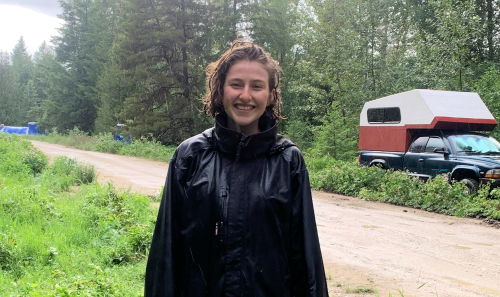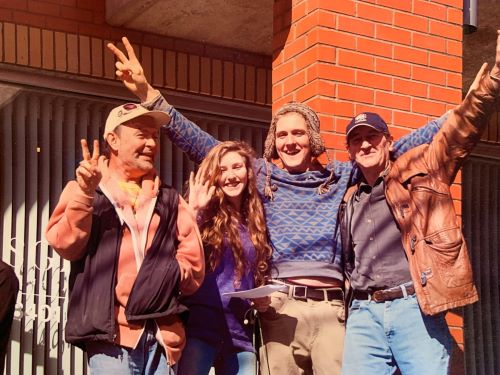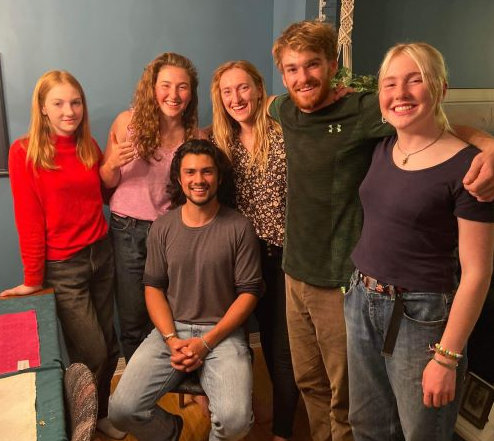Invincible in Both Life and Death

By Bonnie Reynolds
Young Women’s Area Leader
Salt Spring Island, B.C.
Each day, I have experiences that demonstrate the wonderful effect and transformational power of chanting Nam-myoho-renge-kyo[1] . This practice holds a deep and sacred place in my heart. I was lucky to be born into a family that practises Nichiren Buddhism. I grew up going to Buddhist meetings and hearing the dynamic chanting of Nam-myoho-renge-kyo. My earliest memories are of my mom gathering us kids to take us to meetings, and seeing and hearing her chanting through many struggles. Although it was often really difficult to get all of us together and out the door, she persevered. As a result of her efforts, we developed deep bonds of family harmony and trust. Our district leaders, too, were like family. I even remember having birthday parties at their house. They shine with the true ”Soka Gakkai spirit,”[2] embodied in their deep compassion and kindness.
I have a memory from when I was nine years old. My mom was calling me to say that my little sister Sonja was in the hospital with a deep gash on her palm, and that she might lose the use of her hand from nerve damage. My mom encouraged me to chant for Sonja. As a kid, I had a lot of anxiety—in some ways, I still do—and that news really rattled me. I was consumed with worry, and the only option I could see was to chant, just as my mom had said. I prayed for Sonja’s hand to heal, sobbing the entire time. Suddenly, the tension within me began to ease, and I began to feel calm, relaxed, and confident that no matter what happened, things would be okay. Chanting Nam-myoho-renge-kyo helped me so much that I ended up chanting for two hours. Later, Sonja’s hand made a full recovery and miraculously, she did not even have any nerve damage.
I am grateful to my dad for teaching me to do gongyo[3] when I was 13. At the time, when people were doing gongyo, I would usually sit quietly or chant the small segments that I knew. However, he shocked me by insisting that I lead! He gave me a gongyo book and patiently followed along while I stumbled through, guiding me on when and how to ring the bell. At that age, I had very little self-confidence. Often when I went to speak, it would come out in a little squeak. I dreaded school because of my lack of self-esteem; I was really nervous to speak in front of other people and always second-guessed myself. However, using my voice to chant, and being kindly encouraged by my dad, was a major first step in learning to embrace the power of my voice. I began to do gongyo more often, and I always found that after several minutes, the clouds in my mind would roll away, and a feeling of joy would fill my heart.
On May 1, 2016, my brother Justin had a cardiac arrest. He had been running a half-marathon with me, my Aunt Cathy, and my sister Heather. He collapsed 200 metres from the finish line. I remember turning the corner for the final stretch, and I saw a group of people surrounding someone on the ground, with one of them performing CPR. I felt like I was in a dream as I ran by. I turned to see my brother lying on the ground, his body blue. I remember stopping in my tracks and yelling his name, and then one of the medical personnel took me aside to tell me everything would be okay and that I should walk to the finish line and wait for my family. A couple of hours later, we learned that they had managed to restart Justin’s heart with CPR and that he was in a coma, but everything was fine, and he would wake up in a day or two. But a few days later we learned the awful news that the CPR had been ineffective. He had not received enough oxygen to his brain quickly enough, and as a result he would not awaken from his coma. He was very tall, at six feet four inches, and his blood was thick from dehydration, having just run 21 kilometres in the hot sun. These factors contributed to why the CPR had not worked.
I vividly remember sitting in a conference room with my family as we were given that news. Reality as I knew it dropped out from underneath me. Everything was swept away and, left only with grief, I was faced with the raw reality of death implicit within life.
At that point, my entire family surrounded Justin’s bed and began chanting daimoku[4] for hours, as he lay there comatose. We carried on chanting all around the clock, day and night, for the next eight days. I remember watching the hands on the clock, counting the hours as they passed. My voice grew hoarse, but we only let up when exhaustion drove us to fall asleep in our chairs. We would take shifts through the night, chanting beside Justin’s bed.
As we chanted, Justin’s presence in the room was so strong. The change in him was amazing. For the first few days, he was grey and looked unwell, but as we chanted, he became rosy and flushed, and I remember that he looked as though he was surrounded by a golden hue. He was relaxed and looked happy. I felt sure that he was completely aware of what was going on around him, and he understood what we were all going through.
SGI members came at all hours of the day to join us, bringing food, flowers and words of encouragement. Countless friends, family, co-workers and old teachers of Justin’s also came to visit and bring supplies. Although they were not Buddhists, they earnestly chanted daimoku with us at Justin’s bedside. One woman said that Justin had become a Buddha because he was bringing people toward Buddhism and into an enlightened state, even as he was facing death. This corresponds with Ikeda Sensei’s guidance:
“Remember, from the standpoint of the eternity of life, we are ‘Buddhas in life’ and ‘Buddhas in death.’”[5]
I remember a nurse saying that she had never seen such strength and hope in all her years in the ICU. In spite of the immense sadness we all felt, there was a strong underlying feeling of profound meaning and hope. Sensei writes:
The experience of losing a loved one impels us toward a deeper understanding of life. Everyone fears and is saddened by death. That is natural. But by struggling to overcome the pain and sadness that accompanies death, we become sharply aware of the dignity and preciousness of life and develop the compassion to share the sufferings of others as our own. [6]
 A golden memory at the Vancouver Culture Centre.
A golden memory at the Vancouver Culture Centre.
From left: Andrew (friend), Bonnie, Justin (brother), and Jim (father)
Justin was an eligible organ donor, and on the night of May 10, he was scheduled to go into surgery. We chanted with him until past midnight, waiting until the surgeon came to tell us it was time to take him into surgery. Mystically, just before the surgeon came, Justin gave my hand a light squeeze, even though we had been told that physically this wasn’t possible. I told my brother Austin, Justin’s twin, what had happened. Austin took his hand, and Justin gave him a squeeze as well. The timing was mystic; we could definitely sense that it was a farewell from him. Tears began to fall from his closed eyes. We all went together as they wheeled him to the entryway where they invited us to say goodbye. We hugged him, and I kissed his forehead. His skin was literally shimmering like gold. It was a truly profound experience. Justin passed away on May 11, 2016.
I remember thinking that I didn’t know how life would go on after we left the hospital, but the hours of daimoku had established an immovable rhythm in my life that carried me forward. When I left the hospital that day, my dad took me directly to one of my high school track meets. I had missed several others while at the hospital, and I really wanted to go to this one. I poured my whole being into the races, even though I was pretty out of shape from the weeks of sitting at Justin’s bedside.
Despite everything we’d been through, my dad and I were so full of energy and joy that we couldn’t help but share our practice with others. While we were at the track meet and I was running, my dad told my coach about Nam-myoho-renge-kyo and showed her the book Buddhism Day by Day. On receiving the book, my coach said: “Ah! Buddhism! That's it! That’s why you and Bonnie have such wonderful energy!”
Although at the time it didn’t feel unusual, in retrospect it astounds me to think of how I felt that day. I had just gone through the most painful experience of my life; but instead of feeling low, I felt a deep sense of purpose and a fountain of internal energy. I felt like I wanted to challenge everything in front of me.
Sensei writes:
“There is no greater joy, fulfillment, or pride than that which comes from awakening to our eternal mission.”[7]
While at the hospital, a senior leader had told us that when Justin died, a piece of him would go into each of his siblings. I can say for sure that this is true. He had a very strong spirit, and he was full of enthusiasm about everything. His deepest desire was family harmony, and this motivated many of his actions. I am frequently inspired by my brother’s energy, and I consider the greatness of his vision and intent. My brother’s spirit continues to provide me with a source of heartfelt encouragement and strength.
 From left: Ocea (sister), Bonnie, Geronimo (partner),
From left: Ocea (sister), Bonnie, Geronimo (partner),
Heather (sister), Austin (brother) and Sonja (sister)
A metamorphic change occurred within me during this time. I gained an intense clarity into the past, the future, who I was as a person, and the deep meaning within life itself. Before my brother died, I didn’t realize the true power of our practice of chanting Nam-myoho-renge-kyo to change my life. I knew it improved my mood and calmed me down, but it was only after experiencing such harsh suffering that I understood that the effects of this practice do not work on a superficial level. Nam-myoho-renge-kyo reached into the very depths of my being, to the fundamental root of what I am as a human, replacing the darkness with pure light. I vowed to never forget what I had seen and learned.
Sensei writes:
“When we cherish our deceased loved ones in the Eagle Peak within our hearts and carry on their commitment, we can bring forth the most sublime and unbeatable strength.”[8]
After we left the hospital that final day, my mom determined to chant for three hours each day, which she has continued to this day. I can tangibly feel her daimoku in my life. On August 3, 2018, I had the honour of receiving the Gohonzon. Keiko Nakaji, a senior leader from Victoria, came to Salt Spring Island for the ceremony. At the time, I was about to move to Ontario for university. She encouraged me, saying she hoped I would share Nam-myoho-renge-kyo with many people. She said, “Youth are the hope for the future.” These words impacted me greatly. I sensed her prayer to infuse my life with a sense of mission, and I understood that I should not be careless in my life or think that things don’t really matter. In reality, we all have a profound reason for being on this earth.
I feel deeply fortunate to have encountered my best friend Minah and my partner Geronimo in this lifetime. They are the pillars of my life, and they have taught me the meaning of open-heartedness. I am also deeply grateful to my family and my “second family”—the countless Soka Gakkai members who teach me what it means to follow a path of true humanism. In the future, I would like to deepen my understanding of Buddhist humanism and use the philosophy of Soka to illuminate my studies in Political Science and the Russian language in order to work for world peace. I will strive to live the words of my mentor, Daisaku Ikeda:
Nothing is insignificant. Whatever a person’s karma may be, it definitely has profound meaning. This is not just a matter of outlook. Changing the world starts by changing our fundamental state of mind. This is a key Buddhist principle. A powerful determination to transform even negative karma into mission can dramatically transform the real world.[9]
Published in March 2024 New Century
[1] Nam-myoho-renge-kyo: The fundamental Law of the universe expounded in Nichiren Buddhism, it expresses the true aspect of life. Chanting it allows people to directly tap their enlightened nature and is the primary practice of SGI members.
[2] Soka Gakkai spirit: A term used to describe the courageous spirit to never give up based on the same vow as our mentor to work for the peace and happiness of humanity.
[3] Gongyo: Literally, to “exert [oneself in] practice.” Generally speaking, gongyo refers to the practice of reciting Buddhist sutras in front of an object of devotion.
[4] Daimoku: Chanting Nam-myoho-renge-kyo in Nichiren Daishonin’s teachings.
[5] Daisaku Ikeda, The Wisdom for Creating Happiness and Peace, Part 1: Happiness, Chapter 8: Facing Illness. www.sokaglobal.org/resources/study-materials/buddhist-study/the-wisdom-for-creating-happiness-and-peace/chapter-8-8.html
[6] https://www.daisakuikeda.org/sub/quotations/theme/life-death.htmld
[7] Daisaku Ikeda. The Wisdom for Creating Happiness and Peace, Part 2: Human Revolution, Chapter 12: Transforming Karma into Mission. https://www.sokaglobal.org/resources/study-materials/buddhist-study/the-wisdom-for-creating-happiness-and-peace/chapter-12-2.html
[8] New Century, April 2023, p. 2.
[9] Daisaku Ikeda. The Wisdom for Creating Happiness and Peace, Part 2: Human Revolution, Chapter 12: Transforming Karma into Mission, p. 96.

